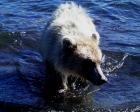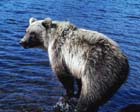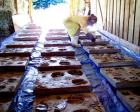
Biscuit in the lake

Chico on a rock

Maureen's sculpture for the exhibit entrance
(Click on any Image to see a higher resolution version)
A helicopter arrived at the cabin late on September 17th and caught me a bit by surprise because the weather was borderline for even those who have the weight and instruments to deal with fog and wind. The landing pad is 150 yards from the cabin and because of the rain and the idea that the weather would put them off, I still had all the stuff undercover at the cabin. Luckily, Tatiana's husband Volodia and another friend came to haul the gear because there was precious little of the day left. It was 5:15 p.m. by the time it was loaded and gone and I was still left with an hours work of securing the cabin shutters for the winter and a three hour flight to the City. At the last minute I grabbed a couple days worth of food to supplement the emergency rations in the plane where I also keep a tent and sleeping bag. I was not sure I could get the whole way before dark, but was reasonably prepared for whatever happened.
I had spotted Chico and Biscuit eating pine nuts near the cabin so went out to say goodbye. The year previous they had also come by just before the helicopter was to pick up Maureen and all our gear. I had not expected to see them such a short time after the roar of the copper. It is always a melancholy time for me.
By the time everything was detailed to my liking another hour had passed. I had been plotting a course in my mind as to how to proceed in order to miss the turbulence the wind was bound to create as it spilled around the volcanoes. This was the sort of day that I would normally have stayed on the ground, but the helicopter pilot had said that the weather might get worse, which meant that I could get caught for another week if I didn't leave then. These are the situations that pilots try not to get into for the sake of their longevity, but I was quite sure that my proposed route would keep me right side up and depending on the amount of headway I could make against the wind, I even had a chance to make it to Petropavlosk.
The first trick I tried didn't work. That was to immediately climb high where there is usually smooth air, but the higher I went the more the wind came around to my nose until I could see that I was standing still in relation to the ground. That meant that I had to fly a low, zig zagging path to put myself on the side of every mountain and valley where the wind was coming up against the terrain and keep away from the lee side where the air was spilling over and tumbling down. By constantly assessing what the air was doing, I was able to use its upward energy and avoid the punishing pitfalls most of the time.
When I have been away from civilization for several months, I feel reluctant to re-enter that world. Eventually the wind let up a bit and it became apparent that I was going to have enough daylight to achieve my destination, and I found myself looking at all the beautiful places that I could have put down for the night. Small lakes surrounded with birches with no evidence that they have been tormented by the wind that we endure down south and meandering rivers through beautiful meadows. The country is so varied and so incredibly wild. One begins to understand however that the reason it is untouched is all just the fluke that there was never enough money in this huge country that made it this far east for the purpose of development. If only the next generation would realize how valuable this resource is, left as it is. I end up with a tail wind that speeds me towards the city and its lights which tell me that there is more electricity than when I left here four months earlier. I land in the twilight by skidding in on the soft grass of the flying school taxiways between the rows of their trainers and am greeted by my wonderful friends who always are delighted that I survived another season.
There was a meeting arranged for Sunday the 19th with officials from Moscow which goes well and I leave the next day feeling that we might have finally overcome most of the problems that have plagued us for so long. Slowly people are beginning to see the importance of what we are learning from our trusting and trusted bears and that the longer that it can be demonstrated that all this good nature is sustainable the more meaningful it all is as something useful to those who have the real and difficult job of actually managing people and bears in places such as North American National Parks.
I am home now and already swept up in all the things that pile upon our plate while we have been away for so long. Maureen has been working on her 3600 lb. cement sculpture that is the entrance to her upcoming exhibition. I am faced with several reports about our years work. I am also determined to get the book that I am working on completed this winter.